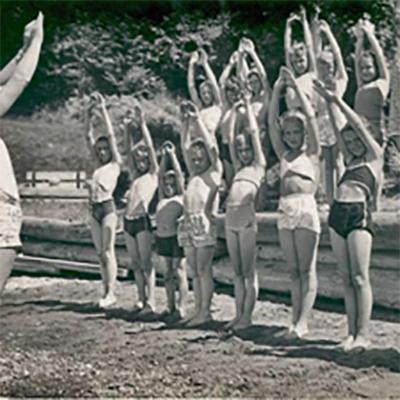
Swimming in the Sound

When the wind blew out of the South at Portage, the water in Quartermaster was always warmer. When the wind came out of the north, the water was always colder. That was the “north wind rule.” The incoming tide warmed itself on the hot sand but a north wind caused us to think twice about swimming in front of the homestead. Dockton followed the “north wind rule” which caused the swimming class to shake from the cold and made our teeth chatter.
David Church chides me to this day with a story that I beat him up on the school bus that took us to swimming lessons, which I needed after having almost drowned in Mukai’s Pond because I couldn’t swim. David could be right, I can’t remember.
The school bus picked us up for swimming lessons whether it was rainy and cold or sunny and warm. Once we were in the water, the weather didn’t seem to matter. They taught us the crawl and we were awed by the older people who could do it. We started learning to swim near the beach in three feet of water where we literally crawled on the bottom, pulling ourselves along with our hands, feeling the buoyancy of the water and kicking with our feet. “Dog paddling” without the support of the bottom was our first swim. I disliked learning to float on my back as a wave would come and send water up my nose, causing gagging and a loss of buoyancy, making me sink feet first. Side stroke and back stroke came after, but I never learned the crawl because I couldn’t synchronize the stroke and turning my head to grab another mouthful of air. I had to settle with learning the breast and side stroke with a scissors kick. I was not going to make a good swimmer.
Finally the day came when we were taken out to the float at the end of the dock and lined up for our first swim in deep water. I was plenty scared from the near drowning accident in Mukai’s pond. Our lifeguard had an oar in his hand to save us if we couldn’t swim back to the float.
I knelt down on one knee on the edge of the rough boards with my hands joined over my head. The water was black, cold and uninviting. The lifeguard never pushed, he just said, “OK Sean, your turn.” My stomach was turning flip-flops as I rolled my body forward into the bay. As soon as the water closed in over my head, I panicked and thrashed around until I could feel the oar in my hands. Several more tries and I was swimming like a fish, or so I thought.
Swimming on the west side of Vashon was a different matter. There was never much of a beach for the tide to come in on and there was a steep drop off at the edge of the low tide mark. Wading out to the drop off was scary, it was as steep as the roof of an “A” frame, almost straight down, making it impossible to stand if you ventured over the edge. The water moved fast, sometimes at 4 knots. It was dark green and hard to see through to the depths where there was no light. It was disconcerting, because Colvos Passage was 300 feet deep.
Kit Bradley was unlike the rest of us who were well-padded and his ribs stuck out and he turned blue from the cold water. His father Brad was a composer and lived in New York. When the iron pipe from the spring leaked, Kits Father wrapped the pipe with a stretched out inner tube.
No Name creek came down from the spring where we got our water. When it reached the beach, it spread out and became another source of adventure. The pebbles in the creek reflected their subdued colors as small trout worked their way up the creek. With a wiggly worm, they were enticed to bite and we had breakfast in the pan, 4 or 5 fish across.
- Login to post comments
